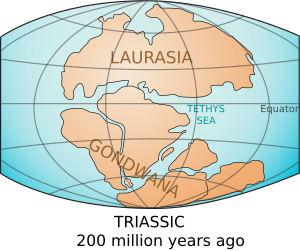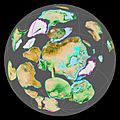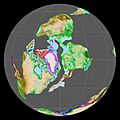Laurasia facts for kids
Laurasia was a huge landmass, like a giant puzzle piece made of many continents stuck together. Scientists call these giant landmasses "supercontinents." Laurasia was the northern part of an even bigger supercontinent called Pangaea.
About 175 million years ago, during the Jurassic period, Pangaea began to break apart. It split into two main parts: Laurasia in the north and Gondwana in the south.
Laurasia included most of the land that makes up the continents we see in the northern hemisphere today. This included what is now North America (which scientists call Laurentia), Europe, a part called Baltica, Siberia, Kazakhstan, and China.
The name "Laurasia" comes from combining "Laurentia" (for North America) and "Eurasia" (for Europe and Asia).
Scientists mostly talk about Laurasia as a supercontinent that existed during the Mesozoic Era (the time of the dinosaurs). However, some scientists believe that the same landmasses that formed Laurasia also came together much earlier. This happened after another supercontinent called Rodinia broke up about 1 billion years ago. To avoid confusion, this older version is sometimes called Proto-Laurasia.
Contents
What Was Laurasia?
Laurasia was one of the two main parts of Pangaea, the largest supercontinent ever known. Imagine all the land on Earth joined together! Pangaea started to break up a long time ago. Laurasia was the northern piece that drifted away.
How Laurasia Formed
The Earth's surface is made of huge plates that are always moving very slowly. This movement is called plate tectonics. Over millions of years, these plates crash into each other or pull apart. This is how supercontinents form and break up.
Laurasia formed when the northern parts of Pangaea began to separate from the southern parts. This separation created new oceans between them.
Continents of Laurasia
Laurasia was not just one big landmass. It was made up of several smaller land areas that are now our modern continents. These included:
- Laurentia: This is what we now call North America.
- Europe: Most of the continent of Europe was part of Laurasia.
- Baltica: This ancient landmass included parts of modern-day Eastern Europe and Scandinavia.
- Siberia: A large part of northern Asia.
- Kazakhstan: A country in Central Asia.
- China: A large part of East Asia.
These landmasses slowly moved apart over millions of years to form the continents we know today.
Proto-Laurasia: An Older Version
The idea of Laurasia is usually linked to the Mesozoic Era, the time when dinosaurs lived. But Earth's history is very long! Scientists have found evidence that the same land areas that formed Laurasia might have been together before.
About 1 billion years ago, there was another supercontinent called Rodinia. When Rodinia broke apart, some of its pieces came together to form an early version of Laurasia. This older version is called Proto-Laurasia. It helps us understand that continents have been moving and reforming for billions of years.
Images for kids
See also
 In Spanish: Laurasia para niños
In Spanish: Laurasia para niños





